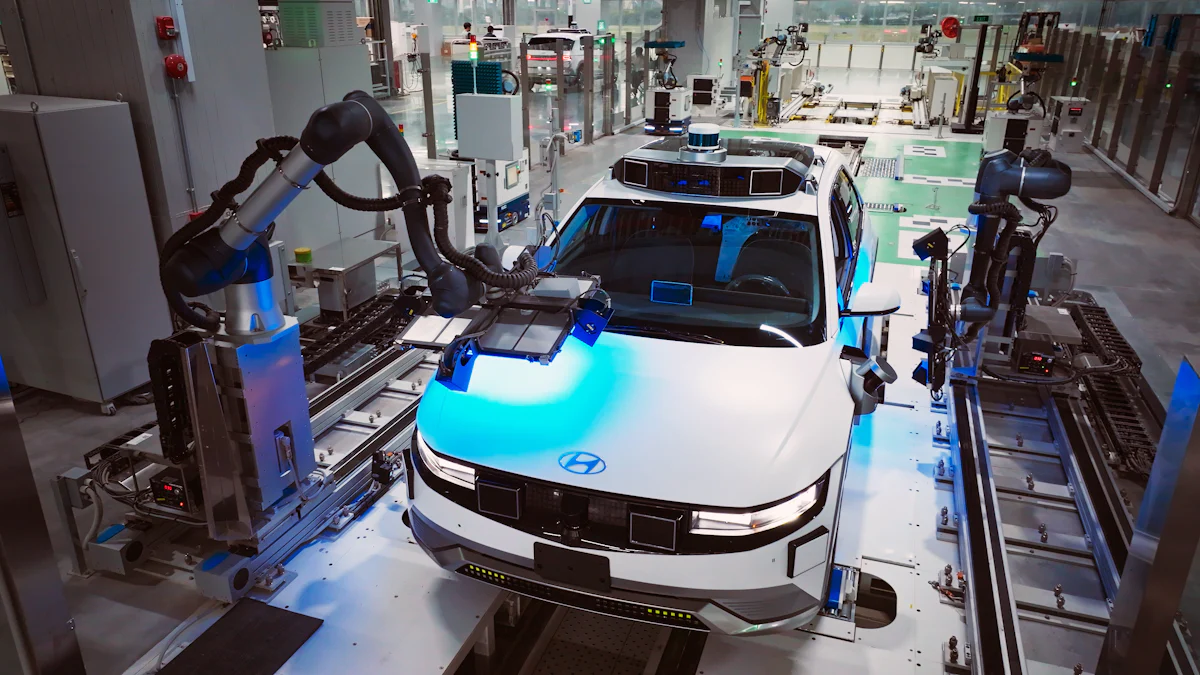The Latest Global Manufacturing trends and their Implications

Staying updated with global manufacturing trends holds paramount importance for industry stakeholders. The rapid pace of change in the sector demands continuous adaptation. Understanding these trends enables businesses to remain competitive and innovative. For instance, manufacturers have increased investments in factory robotics and automation, leading to decreased costs. The Purchasing Managers' Index (PMI) provides insights into economic drivers such as GDP, inflation, and employment, highlighting the industry's dynamic nature.
Global Manufacturing Trends: Automation and Robotics

Increasing Adoption of Automation
Manufacturers are increasingly adopting automation to achieve several key objectives. Automation improves worker safety, reduces costs, enhances quality, and increases flexibility. For example, automated systems can handle repetitive tasks, reducing the risk of workplace injuries. This shift enables workers to focus on more complex and strategic activities.
Impact on Labor Market
The adoption of automation significantly impacts the labor market. Automation reduces the demand for low-skilled labor while increasing the need for skilled workers who can operate and maintain automated systems. This trend necessitates workforce retraining and upskilling to meet the new demands of the industry. Companies investing in automation must also invest in their employees' education and training.
Efficiency and Productivity Gains
Automation leads to substantial efficiency and productivity gains. Automated systems can work continuously without breaks, leading to higher output levels. These systems also improve accuracy and repeatability, ensuring consistent product quality. According to JR Automation, manufacturers who install robotics and automation solutions see improvements in productivity, accuracy, and quality.
Advances in Robotics Technology
Robotics technology has advanced significantly, offering new opportunities for manufacturers. These advancements include the development of collaborative robots (cobots) and the integration of AI and machine learning.
Collaborative Robots (Cobots)
Collaborative robots, or cobots, are designed to work alongside human workers. Cobots enhance productivity by performing tasks that require precision and consistency. These robots are easy to program and can be quickly integrated into existing production lines. Cobots also improve workplace safety by handling hazardous tasks.
AI and Machine Learning Integration
The integration of AI and machine learning into robotics technology represents a significant advancement. AI-powered robots can analyze data in real-time, making intelligent decisions that optimize production processes. Machine learning algorithms enable robots to learn from experience, improving their performance over time. McKinsey & Company reports that companies are betting big on robotics and automation, with automated systems expected to account for 25 percent of capital spending over the next five years.
Global Manufacturing Trends: Sustainable Manufacturing

Environmental Regulations and Compliance
Reducing Carbon Footprint
Manufacturers must comply with stringent environmental regulations to reduce their carbon footprint. Governments worldwide enforce laws that mandate emission reductions. Companies need to adopt cleaner technologies and renewable energy sources. These measures help in minimizing greenhouse gas emissions. For instance, many factories now use solar panels and wind turbines to power operations. This shift not only meets regulatory requirements but also promotes sustainability.
Waste Management Innovations
Effective waste management has become crucial for sustainable manufacturing. Companies must innovate to handle waste responsibly. Recycling and reusing materials can significantly reduce waste. Advanced waste treatment technologies convert industrial waste into reusable resources. For example, some manufacturers use bio-digesters to convert organic waste into biogas. This approach aligns with environmental regulations and enhances operational efficiency.
Circular Economy Practices
Recycling and Reuse
Recycling and reuse form the backbone of circular economy practices. Manufacturers must design products with end-of-life recycling in mind. This practice involves using materials that can be easily recycled. Companies also focus on reusing components to extend product life cycles. For example, the automotive industry often refurbishes parts to reduce waste. This strategy conserves resources and reduces environmental impact.
Sustainable Supply Chains
Building sustainable supply chains is essential for modern manufacturing. Companies must ensure that suppliers adhere to environmental standards. This practice involves auditing suppliers for compliance with sustainability criteria. Manufacturers also prioritize sourcing materials from eco-friendly suppliers. For instance, many electronics companies now source conflict-free minerals. This approach ensures ethical practices throughout the supply chain.
Global Manufacturing Trends: Digital Transformation
Industry 4.0 and Smart Factories
Industry 4.0 represents the fourth industrial revolution. This revolution emphasizes smart factories and digital transformation. Manufacturers leverage advanced technologies to enhance operational efficiency and productivity.
Internet of Things (IoT) Integration
The Internet of Things (IoT) plays a crucial role in smart factories. IoT devices collect and transmit data in real-time. This data provides valuable insights into production processes. Manufacturers use these insights to optimize operations and reduce downtime. For example, sensors monitor equipment performance and predict maintenance needs. This proactive approach minimizes disruptions and extends machinery lifespan.
Data Analytics and Predictive Maintenance
Data analytics is essential for modern manufacturing. Advanced algorithms analyze vast amounts of data from IoT devices. These analyses identify patterns and trends that inform decision-making. Predictive maintenance is a key application of data analytics. By predicting equipment failures, manufacturers can schedule maintenance before issues arise. This approach reduces unplanned downtime and improves overall efficiency.
Cybersecurity Challenges
Digital transformation introduces new cybersecurity challenges. As manufacturers adopt connected technologies, the risk of cyberattacks increases. Protecting sensitive information and ensuring operational continuity become critical priorities.
Protecting Intellectual Property
Intellectual property (IP) protection is vital for manufacturers. Cybercriminals target valuable IP, such as trade secrets and proprietary designs. Robust cybersecurity measures safeguard this information. Encryption, access controls, and regular security audits help protect IP. Companies must invest in advanced cybersecurity solutions to prevent data breaches.
Ensuring Operational Continuity
Operational continuity is essential for manufacturing success. Cyberattacks can disrupt production and cause significant financial losses. Manufacturers implement comprehensive cybersecurity strategies to mitigate these risks. These strategies include network segmentation, intrusion detection systems, and employee training. By ensuring robust cybersecurity, manufacturers maintain continuous operations and protect their bottom line.
Global Manufacturing Trends: Global Supply Chain Resilience
Diversification of Supply Sources
Manufacturers must diversify supply sources to enhance resilience. Relying on a single supplier increases vulnerability to disruptions. Diversification mitigates risks and ensures continuous operations. Companies seek multiple suppliers for critical components. This approach reduces dependency and enhances flexibility.
Reducing Dependency on Single Suppliers
Reducing dependency on single suppliers is crucial. A single point of failure can halt production. Manufacturers need alternative sources for essential materials. This strategy ensures a steady supply chain. Companies must evaluate and qualify multiple suppliers. This process involves rigorous assessments and quality checks.
Regionalization of Supply Chains
Regionalization of supply chains offers significant benefits. Localizing production reduces transportation costs. Proximity to markets shortens lead times. Regional supply chains also enhance responsiveness. Companies can quickly adapt to market changes. Regionalization supports sustainability goals by lowering carbon emissions.
Risk Management Strategies
Effective risk management strategies are vital for supply chain resilience. Manufacturers must identify potential risks and develop mitigation plans. Proactive measures ensure operational continuity. Companies need robust frameworks for risk assessment. These frameworks guide decision-making and resource allocation.
Contingency Planning
Contingency planning prepares companies for unforeseen events. Manufacturers must develop comprehensive contingency plans. These plans outline steps to address disruptions. Companies need backup suppliers and alternative logistics options. Contingency planning minimizes downtime and financial losses. Regular reviews and updates keep plans relevant.
Real-time Monitoring and Response
Real-time monitoring and response enhance supply chain resilience. Advanced technologies enable real-time data collection. Manufacturers use this data to monitor supply chain performance. Early detection of issues allows prompt action. Real-time response minimizes the impact of disruptions. Companies invest in systems for continuous monitoring and rapid response.
JUSDA Supply Chain Management International Co., Ltd. is at the forefront of leveraging the latest global manufacturing trends to enhance its supply chain management services. Here are some key trends and their implications as observed from JUSDA's operations:
Trend: The integration of digital technologies such as big data, cloud computing, and IoT into supply chain management.
Implications: JUSDA has developed the JusLink intelligent system platform, which supports both internal and external customers' supply chain management needs. This platform enables real-time collaboration, precise business decision analysis, and efficient resource utilization. The use of big data analysis and IoT integration helps in achieving a collaborative and intelligent supply chain ecosystem.
End-to-End Supply Chain Solutions (C2M2C):
Trend: The shift towards end-to-end supply chain solutions that connect customers directly to manufacturers and then to consumers.
Implications: JUSDA's C2M2C model is a disruptive upgrade to traditional supply chains, starting from consumer demand and influencing upstream supply chain processes. This model enhances flexibility, efficiency, and responsiveness to market demands, ensuring that manufacturing adjustments are made based on real-time consumer needs.
Global Strategic Layout and Expansion:
Trend: The expansion of supply chain networks to cover global markets.
Implications: JUSDA has established a comprehensive global network with service points, warehousing, and logistics operation centers across North America, Europe, Asia, and Australia. This global presence allows JUSDA to provide seamless cross-border logistics and supply chain services, supporting international trade and manufacturing.
Lean Supply Chain Management:
Trend: The adoption of lean principles in supply chain management to reduce waste and improve efficiency.
Implications: JUSDA's expertise in lean supply chain management, particularly in the 3C (computer, communication, and consumer electronics) manufacturing sector, enables it to offer highly efficient and cost-effective supply chain solutions. This approach is extended to other industries, including automotive and cross-border new retail.
Innovative Business Models and Real-Time Collaboration:
Trend: The development of innovative business models that promote real-time collaboration and integration across the supply chain.
Implications: JUSDA's focus on building a real-time collaborative supply chain ecosystem involves integrating suppliers, manufacturers, service providers, and customers into a unified platform. This enhances the ability to respond to complex and variable customer demands, ultimately improving overall supply chain performance.
Cross-Border Trade and E-Commerce:
Trend: The rise of cross-border trade and e-commerce as significant components of global supply chains.
Implications: JUSDA offers specialized services for cross-border trade, including direct special lines, overseas warehouse distribution, and first-mile logistics. These services cater to the needs of merchants, manufacturers, and consumers, ensuring efficient and seamless cross-border transactions.
By staying aligned with these global manufacturing trends, JUSDA continues to enhance its supply chain management capabilities, providing comprehensive and innovative solutions to meet the evolving needs of its customers worldwide.
JUSDA Solutions
To provide you with professional solutions and quotations.
The blog has discussed key trends in global manufacturing, including automation and robotics, sustainable practices, digital transformation, and supply chain resilience. Adapting to these trends is crucial for future success. Companies must invest in advanced technologies and workforce training. Proactive measures ensure competitiveness and innovation. Continuous learning keeps businesses ahead in the industry. The rapid pace of change demands that manufacturers stay informed and agile. Embracing these trends will position companies for long-term growth and sustainability.
See Also
Maximizing Manufacturing Success in 2024 Through Supply Chain Strategies
Upcoming Supply Chain Effectiveness: 5 Influential Trends
Efficient Resolutions for High-Tech Manufacturing's Supply Chain Challenges
Unlocking Triumph: High-Tech Manufacturing Consultation Demystified
Guiding Efficient Logistics for High-Tech Manufacturing Triumph
